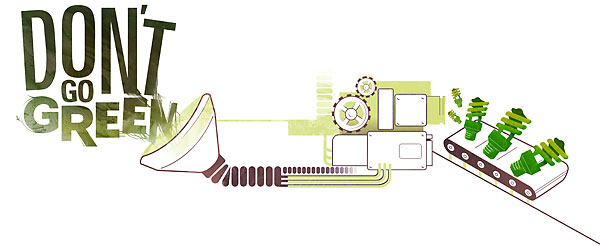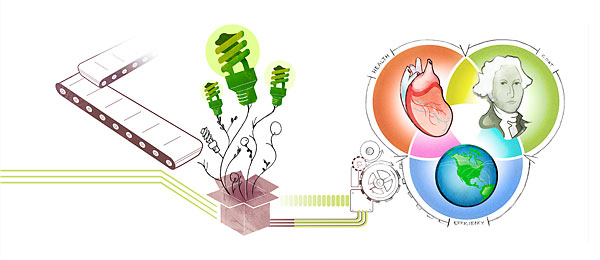
Forget about global warming, deforestation, the energy crisis and overflowing landfills. They are out of your control. Ignore the polarizing green politics. Ignore the green activists. They have their own agendas. You don’t have to be scolded and lectured about green products, green services and green activities. You don’t have time in your life to even keep up with the rhetoric, much less have the energy to be guilt tripped into turning your life upside down just to keep up with the latest and greatest trend. What are you supposed to do – move into a yurt, build a Fred Flinstone car, dig a pit latrine and make your own candle wax?
Nevermind the black market, nowadays everyone is trying to get rich off the green market; it’s legal and has a predator’s appetite. Green marketers are on the loose. So-called greenwashers claim to be environmentally friendly when all they have done is create an energy-efficient product using really hazardous materials. Perhaps they slapped a green-certified stamp on something even though that particular certification does not exist; or, in bold letters, the product says it is 100 percent natural, failing to mention that it contains hazardous natural materials like arsenic and formaldehyde.
Even seemingly legitimate advances “new technologies and new fuels” swap pros and cons in almost equal measure. CFL light bulbs cost a lot more and last a lot longer. Are they worth it? It would seem so, except they are difficult to recycle and are much more likely to break – releasing toxic mercury – before they ever hit the landfill. Artificial grass does not need water, a plus, but the three largest artificial grass producers are currently being sued in California because their products contain lead. Hydrogen is the most abundant chemical in the atmosphere. Will it be the fuel of the future? Possibly, except there is increasing concern that its dependence on plutonium, used to refine hydrogen, might again result in a fuel that is dependent on a scarce resource. Then there is ethanol. Putting aside the amount of non-renewable petroleum required to process ethanol, what sense does it make to use our agricultural land to feed our cars? Meanwhile, you have needs: financial, logistical, lifestyle. With limited time and resources, how many of your decisions can be based on whether or not something is green? Your motivators are more practical, more immediate. You don’t demand much. All you want is something reasonably healthful, inexpensive and efficient. Beyond that, who really cares?
Responsible consumption in the midst of such a shift, the future of which history has yet to illuminate, is a bona fide minefield. We do not have the philosophical architecture, never mind the actual infrastructure, to construct a truly meaningful and lasting environmental policy. Because the terminology is still so elastic and the conversation so draining, consumers are vulnerable. And here we hit against the fatal flaw of the current green conversation. With companies scrambling for a foothold in the burgeoning green market, consumers’ attention is concentrated on supply, which can lead to poor decision-making. Consumers’ real power, which many argue is tantamount to real innovation, lies in demand.
The impact of consumer demand – how you choose to spend your money – maybe be subtle, but informed decision making can nonetheless go a long way in defining the marketplace. With health, cost and efficiency locked into an eternal struggle for equilibrium, it is all too easy – thanks to any number of factors ranging from slick marketing to artificially low prices – to choose cost over health or greater sustainable efficiency. But in a time of intense innovation, experimentation and financial profiteering, the consumer is uniquely positioned to guide the market toward sustainability.
As a smart consumer, you want something healthful, inexpensive and efficient. Thankfully, smart companies listen to smart consumers. They recognize that people who plan to buy something will consider environmental issues in their decision. But rather than chase a green label or a green marketing campaign, they return instead to the three fundamental concerns of the consumer: health, cost and efficiency. And that not only translates into greener and more sustainable products and services, it is also a marketing strategy that can be converted into sales.
Indeed, experts across industries increasingly agree that commerce and environment are not at odds. The commercial “sweet spot”, as David Newcombe, a Phoenix-based realtor well versed in green real estate, puts it, falls precisely at the intersection of health, cost and efficiency. He points to the example of GreenBuilt, a pioneer in the green real estate market. Having difficulty generating interest in their green houses, the feedback from those that did purchase from them consistently focused on the overall superiority of the homes. Switching tack accordingly, GreenBuilt assumed a marketing approach that focused more on their products’ efficiency and quality rather than the greenness of their homes.
Shawn Collins, an engineer with Rolls Royce, suggests Toyota’s Prius as another example. He attributes its phenomenal success and formidable market brand less to its fuel efficiency and more to the fact that its innovative engineering all but eclipses the novelty of its fuel efficiency. Collins, who has a PhD in anthropology, argues that this type of innovation stems from a sensitivity to evolving consumer demand and not, as many might assume, from an effort to go green.
My argument is this: by keeping green focused on consumer demand, the marketplace, which is our best hope to effect a greener world, is pinned to a reliable roadmap. The right kind of demand will result in the right kind of supply. Demand health, cost-effectiveness and efficiency. Green will follow. Stay focused on your needs and you just might wind up greener than a feral hippie. [Illustrations: Ryan Lowry]

Thanks to David Newcombe, Shawn Collins, Deborah Schneiderman and Dan Kaup for their contributions to this article.


















